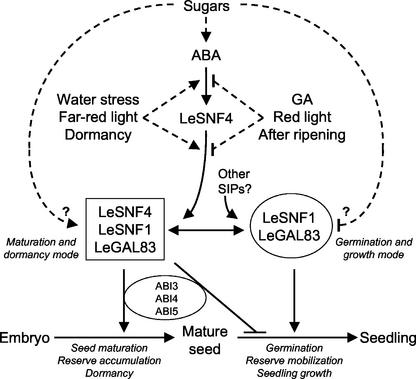Figure 10.
Regulation and hypothetical roles of the SnRK1 complex during seed maturation and germination. This scheme combines recent models (e.g. Gazzarrini and McCourt, 2001; Rook et al., 2001) with data presented here for the tomato SnRK1 complex. ABA synthesis during seed development or in response to high sugar levels during germination results in ABA accumulation, inducing LeSNF4 expression. Additional factors promoting LeSNF4 expression are shown on the left of the ABA signaling pathway, whereas those inhibiting expression are shown on the right. Dashed lines both above and below LeSNF4 are shown because it is unclear where each of these factors acts in influencing expression. When LeSNF4 is present, it binds with LeSNF1/LeGAL83, potentially altering the kinase activity or its interaction with other regulatory factors or substrates, resulting in the maintenance of a “maturation/dormancy” metabolic state and inhibiting reserve mobilization. When LeSNF4 is absent, LeSNF1 may have altered activity, specificity, or interactions with other SIPs, resulting in transition to the “germination/growth” mode required for reserve mobilization and seedling growth. In either of the metabolic modes, the activity of the LeSNF1 complex may be sensitive to regulation by sugars (indicated by the broken lines) and could be involved in the regulation of ABI3, ABI4, and ABI5 and other proteins that are known to influence the transition from seed maturation and dormancy to germination and growth. (Arrows indicate promotion; bars indicate inhibition.)

